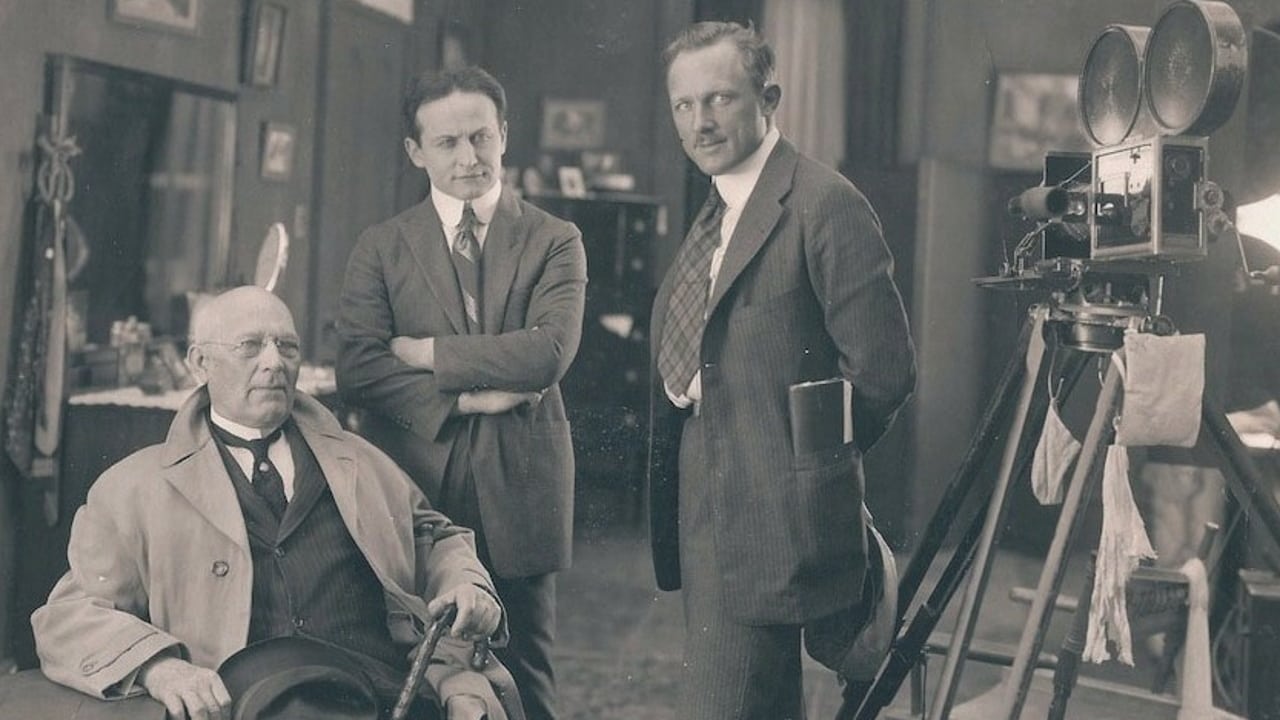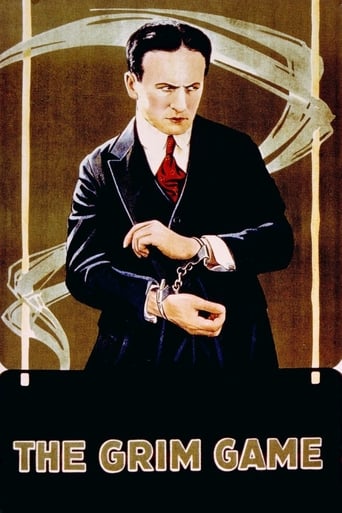

Do you really need a recommendation to watch this restored film from 1919? Come on - the real Harry Houdini is in it! A couple of other reviewers here go into the film's discovery and restoration with the cooperation of the Turner Classic Movie channel so there's no need to go into that. What's rather extraordinary is the fact that there's actually a real story here, a murder mystery that evolves from a rather shady plan orchestrated by newspaper reporter Harvey Hanford (Houdini himself!) in order to save the financially struggling Daily Call. It involved faking the owner's death, with Hanford setting himself up to be incriminated for murder, and then after a time, the owner Dudley Cameron (Thomas Jefferson) would simply show up none the worse for wear. In the mean time, the newspaper capitalizes on the publicity, saving itself via a news hungry public buying it's coverage of the story.This picture is considered the first and best of five movies Harry Houdini participated in. I haven't seen the others so there's no way to judge for my part. What I can say with this one viewing is that Houdini himself presents a very versatile, athletic and highly physical dimension to the role portraying his character Hanford. The movie itself is a forum for capturing some of his most famous escape routines on film, including a prison break where he extracts himself from a series of chains, along with a daring upside down escape from a straight jacket hanging a few stories in the air. I was also impressed by a maneuver that stunt man Yakima Canutt eventually made as one of his trademarks. Following the prison escape, Houdini scrambles underneath a moving vehicle and hangs on to the undercarriage to make a clean getaway. Quite impressive.As for the main story, a trio of individuals that are part of Dudley Cameron's circle agree to participate in Hanford's ruse, but then operate independently, each for their own benefit. With Hanford on the run from the now very real murder of Cameron, it will take all of his cunning to flush out the real killer and save his fiancée Mary (Ann Forrest), ward and heiress to the Cameron fortune. The picture ends with a thrilling airplane chase leading to a mid-air collision and plane crash, though the two planes involved in the original stunt actually landed safely.The quality of the restoration is laudable and the movie itself looks to be reasonably complete. At about the one hour mark there are significant imperfections that apparently could not be improved upon at both outer margins, and the effect appears almost psychedelic, like something you might have seen musical groups of the Sixties use during appearances on variety shows of that era. At least that's the way it struck this viewer. Otherwise, the quality of the picture is rather exceptional, no mean feat for a film approaching the century mark.
... View MoreThe fact is that the "The Grim Game" was considered lost. Actually the only existing copy of the 71-minute feature was lovingly preserved by a private party (Larry Weeks) in Pennsylvania. In 2014, after financing by Turner Classic Movies (TCM), it was restored with a new music score; it was first televised in 2015.The first title card reads, "Remote and isolated, behind high walls and barred gates, the Cameron home repels intrusion." There is even an armed guard at the main entrance. Nevertheless, Harvey Hanford (Harry Houdini) is able to enter through the side gate. He, a reporter for the Daily Call, is in love with Mary Wentworth (Ann Forrest). He has come to see her. But the wealthy recluse Dudley Cameron (Thomas Jefferson) is at odds with nephew Harvey. Now Cameron is cared for by his ward and heiress, Mary Wentworth (Ann Forrest) and two servants. Harry eagerly tells Mary that her first story will appear in Sunday's newspaper. It has been stipulated in Dudley Cameron's will that Mary will be unable to marry while he lives. Cameron has planned for Mary to marry Doc Tyson (Arthur Hoyt) after his death. Doc Tyson is a shifty type. Cameron has previously lent the owner of the Daily Call, David Allison (Augustus Phillips) cash to keep the paper afloat, but refuses to give any more. Phillips is desperate. Meanwhile lawyer Nick Raven (Tully Marshall) is in deep cow-plop. For Cameron has caught him forging his signature. Cameron will not turn in Raven as long as he does Cameron's will. So now we have met the three schemers: Tyson, Allison, and Raven. But they work independently of each other. Knowing that the Daily Call is failing, Harvey presents his plan to the three men. It is intricate and involves a false kidnapping, the temporary disappearance of Cameron. Harvey has also purposely planted evidence to incriminate himself. Of course, the main bad guy turns it into murder; Cameron's body is discovered in a well on his property. Harvey Hanford is accused and eventually imprisoned – but as he is really Houdini after all – he engineers a series of fantastic escapes, beginning with his breakout from prison shackles. He even slips away after he is tied up in a strait-jacket upside down alongside a multi-story building. There are several coincidences typical of many silent films, but Houdini hangs in there and shows his abilities and his stamina. Finally there is the aerial stunt: a biplane with the hero actually flying chasing another airplane with the bad guy (and Mary). It concludes with a real crash. Although the script offers little suspense until the last reel, this film is quite good, and it was nice to see the great escape artist/stage magician in action. Houdini was even a skilled aviator. He was born in Budapest, Hungary when it was part of the old Austro-Hungarian Empire. He immigrated to the USA in the nineteenth century and was raised in Appleton, Wisconsin. His attractive co- star, Ann Forrest, born in Denmark, was quite camera-friendly on screen. She makes a desirable lady-in-distress. The feature itself is a curio that should offer bona fide entertainment for movie buffs. It is said that perhaps 80% of all silent films are lost, so it is nice to have this one back from the grave.
... View MoreWith financing from TCM, the only known print of Houdini's first film was restored to near-perfect condition (except for some deterioration damage toward the end) and found its television premiere on TCM on Sunday, October 18, 2015. A recap of the finding and restoring of the film can be found in ellebrennan's review here of October 20. Although Brennan's recap (excerpted from Houdini.org) credits renowned composer Brane ivković with having created a new score for the restoration, what neither hers nor any other review here to date of the restored film mentions is that TCM showed the film twice that night, first with ivković's score, then again later with a more traditional silent film score by Steve Sterner. Unfortunately, I missed what host Robert Osborne may or may not have said about the Sterner score, but in my estimation, although less innovative, it may in some way be preferable. ivković's score is thematically more operatic in that characters have their own themes assigned to them. Since Houdini (and his character) is on the screen so much throughout the film, his theme eventually becomes monotonous. Variations of his theme would be highly appreciated. Sterner's score, being more traditional as silent film scores go, does not vary with the characters, per se, but if with anything, the action. Let the discussion begin.
... View MoreHarry Houdini reminds me of Jackie Chan. Both of them starred in action movies with implausible plotlines which were basically excuses to string together a series of stunts designed to showcase the star's particular talents: in Houdini's case, his incredible physical stamina and his ability to escape from all sorts of restraints. The plot of "The Grim Game" is basically a long string of stunts, but Houdini performs them with panache, and modern audiences will enjoy this film. The story is written primarily by Arthur B. Reeve, creator of the scientific detective Craig Kennedy (who was parodied by Douglas Fairbanks as "Coke Ennyday").Harry Houdini stars as Harvey Hanford (same initials) who is engaged to marry Mary Cameron (Ann Forest). When Mary's guardian is murdered, Houdini is framed for the crime and sent to prison. He escapes (of course!) and then goes after the villains, but they keep chaining him up or imprisoning them, and of course Houdini keeps right on escaping. At one point they leave him hanging upside-down in a straitjacket off the roof of a skyscraper. No problem, and Houdini is home free before the villains can take the elevator back to street level.At the film's climax, the boss villain abducts Mary (of course) and flies away with her in a rickety biplane, which was a state-of-the-art aircraft when this film was made in 1919. Houdini jumps into another aeroplane and takes off in pursuit. The two 'planes crash in midair (nice photography here), but Houdini and his girlfriend get back to the ground in one piece... or rather, in one piece apiece.The entire film is thrilling but largely implausible. Houdini's feats are genuine, but the stunts are clearly designed to play to Houdini's strengths rather than realistic situations. The airborne climax takes advantage of the fact that, in real life, Houdini was a skilled aviator. (He was the first person ever to fly an aircraft in Australia.)"The Grim Game" is enjoyable, and parts of it are fast-moving, but don't look for a logical storyline. (The villains have no qualms about committing murder, so why don't they just kill Houdini instead of always chaining him up?) In the best sense of the term, this movie is escapist entertainment.
... View More